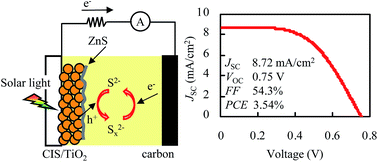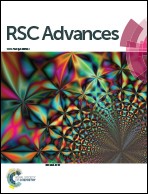Inorganic dye-sensitized solar cell employing In-enriched Cu–In–S ternary colloids prepared in water media†
Abstract
Copper–indium–sulfur (CIS) ternary colloids with different chemical compositions (In/Cu = 1, 2, 3 and 4) were synthesized in “green” water media at 298 K. It was observed that these CIS colloidal particles possess identical crystal structures in tetrahedron. They exhibit energy gaps at 1.7–2.0 eV, which is attributed to the quantum size effects through a decrease of particle sizes from 4 to 2 nm. It was also found that the photoelectrodes employing CIS colloids with the In-enriched compositions exhibit high incident photon to current efficiency (IPCE) up to ca. 780 nm. The solar cell constructed by CIS–TiO2||Sx2−/xS2−||carbon electrode exhibited a power conversion efficiency (PCE) up to ca. 2.5%. Furthermore, the CIS–TiO2 photoelectrode coated with ZnS as passivation layers by SILAR processes exhibited a remarkable improvement of the PCE up to 3.54% (short-circuit current: 8.72 mA cm−2, open-circuit voltage: 750 mV and fill factor: 53.6%). Effects of chemical compositions and ZnS coating to the photoelectrodes were further discussed by electrochemical impedance spectroscopy.


 Please wait while we load your content...
Please wait while we load your content...